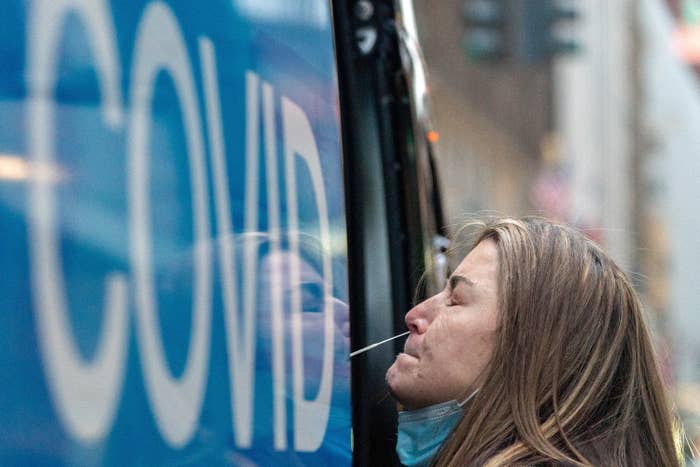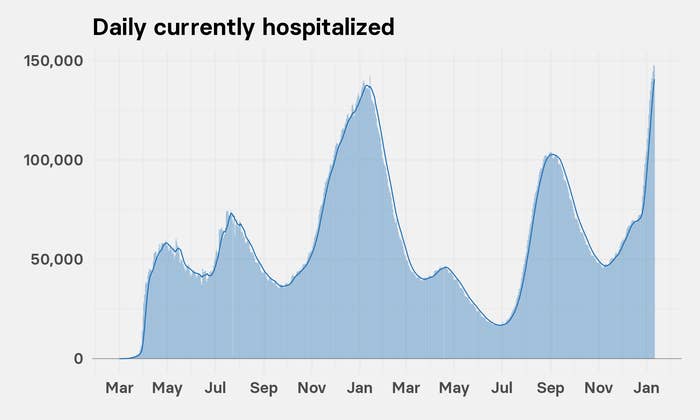“It’s going to get worse before it gets better,” one doctor said.
Dan Vergano BuzzFeed News Reporter
Posted on January 12, 2022

Jeenah Moon / Reuters
A woman takes a COVID test in New York City, Dec. 27, 2021.
The paradox of Omicron, now responsible for an estimated 98.3% of all US coronavirus cases, is that while it seems more likely to result in significantly milder outcomes than Delta and previous variants, the health system is as stressed as it’s ever been.
Public health officials are warning that Omicron is threatening to overwhelm the medical infrastructure with sheer numbers, and hospitals are filled with seriously ill patients.
“It's going to get worse before it gets better,” said Dean Blumberg, a pediatrician and infectious disease expert at the University of California, Davis.
Here’s what we know about why this is happening:
Omicron is more contagious
The variant appears to be roughly two to five times more transmissible than Delta, which previously dominated US cases.
“This is the second-most contagious disease in the world now, second to measles,” said Sara Murray, the director of the health informatics data science and innovation team and an associate professor of clinical and hospital medicine at the University of California San Francisco.
“While we are seeing early evidence that Omicron is less severe than Delta and that those infected are less likely to require hospitalization, it's important to note that Omicron continues to be much more transmissible,” CDC Director Rochelle Walensky said on Wednesday.
This means that even though a smaller percentage of patients infected with Omicron require hospitalization, the total number of COVID cases is so high that hospitals are seeing more of those patients than at any point in the pandemic.
COVID-19 cases have reached record levels in the US, averaging around 1.4 million new reported cases a day, itself an undercount. Daily, an average of 19,800 people nationwide are now admitted to hospitals with COVID, according to the CDC, a 33% increase over the past week. Almost a third of intensive care unit beds nationwide are now filled with COVID patients, meaning roughly 1 out of every 2.5 people in an ICU ward in the country has the virus

Peter Aldhous/BuzzFeed News / Via Department of Health and Human Services
The number of patients currently hospitalized with COVID-19 in the US.
More patients are being admitted “with” COVID
COVID is so widespread right now that a significant percentage of hospitalized patients are admitted for something else but then test positive upon screening at admittance.
“We test a lot of asymptomatic patients in preparation for procedures or surgeries, planned hospitalizations — and even in those folks who are totally asymptomatic, we're seeing a case positivity right now of about 12%,” Murray said.
“It’s a very different landscape that we're seeing with overcrowding in the hospital than we've seen with the prior waves of COVID,” said Richelle Charles, an infectious disease expert at Massachusetts General Hospital and Harvard Medical School. “Almost half of these cases are in the hospital for non-COVID-related illnesses.”
At UCSF, Murray said overall about two-thirds of their COVID patients were hospitalized for the disease, while one-third were hospitalized with it. In pediatric COVID patients, about half of them were admitted for something other than the disease.
Yet even if these patients' COVID symptoms are mild or nonexistent, their positive status places an extra burden on the hospital because they require isolation and extra safety protocols for hospital staff.
Posted on January 12, 2022

Jeenah Moon / Reuters
A woman takes a COVID test in New York City, Dec. 27, 2021.
The paradox of Omicron, now responsible for an estimated 98.3% of all US coronavirus cases, is that while it seems more likely to result in significantly milder outcomes than Delta and previous variants, the health system is as stressed as it’s ever been.
Public health officials are warning that Omicron is threatening to overwhelm the medical infrastructure with sheer numbers, and hospitals are filled with seriously ill patients.
“It's going to get worse before it gets better,” said Dean Blumberg, a pediatrician and infectious disease expert at the University of California, Davis.
Here’s what we know about why this is happening:
Omicron is more contagious
The variant appears to be roughly two to five times more transmissible than Delta, which previously dominated US cases.
“This is the second-most contagious disease in the world now, second to measles,” said Sara Murray, the director of the health informatics data science and innovation team and an associate professor of clinical and hospital medicine at the University of California San Francisco.
“While we are seeing early evidence that Omicron is less severe than Delta and that those infected are less likely to require hospitalization, it's important to note that Omicron continues to be much more transmissible,” CDC Director Rochelle Walensky said on Wednesday.
This means that even though a smaller percentage of patients infected with Omicron require hospitalization, the total number of COVID cases is so high that hospitals are seeing more of those patients than at any point in the pandemic.
COVID-19 cases have reached record levels in the US, averaging around 1.4 million new reported cases a day, itself an undercount. Daily, an average of 19,800 people nationwide are now admitted to hospitals with COVID, according to the CDC, a 33% increase over the past week. Almost a third of intensive care unit beds nationwide are now filled with COVID patients, meaning roughly 1 out of every 2.5 people in an ICU ward in the country has the virus

Peter Aldhous/BuzzFeed News / Via Department of Health and Human Services
The number of patients currently hospitalized with COVID-19 in the US.
More patients are being admitted “with” COVID
COVID is so widespread right now that a significant percentage of hospitalized patients are admitted for something else but then test positive upon screening at admittance.
“We test a lot of asymptomatic patients in preparation for procedures or surgeries, planned hospitalizations — and even in those folks who are totally asymptomatic, we're seeing a case positivity right now of about 12%,” Murray said.
“It’s a very different landscape that we're seeing with overcrowding in the hospital than we've seen with the prior waves of COVID,” said Richelle Charles, an infectious disease expert at Massachusetts General Hospital and Harvard Medical School. “Almost half of these cases are in the hospital for non-COVID-related illnesses.”
At UCSF, Murray said overall about two-thirds of their COVID patients were hospitalized for the disease, while one-third were hospitalized with it. In pediatric COVID patients, about half of them were admitted for something other than the disease.
Yet even if these patients' COVID symptoms are mild or nonexistent, their positive status places an extra burden on the hospital because they require isolation and extra safety protocols for hospital staff.
Staffing shortages from exposure and burnout
Hidden in the increasing case numbers are doctors, nurses, and other healthcare personnel infected by the more contagious variant, which causes more breakthrough infections among the vaccinated than past ones, said Akin Demehin, the policy director at the American Hospital Association. Even with mild infections, those healthcare workers are still out of action for a week after their tests turn negative, per CDC policy, just as the surge fills up hospitals and drives up demand for staff.
The Omicron surge will only put more stress on doctors and nurses, who still have to care for all those extra patients. One survey last August reported that nearly 60% of doctors feel burned out, Demehin said, and that was two surges ago. “We hear this from hospital leaders all the time — their number one, two, and three priority right now is workforce,” he said. “They know just how much has been asked of healthcare providers over the past almost two years.”
More young children
“This time around, we're seeing more children less than 5 years of age,” Blumberg said.
He has observed that many of them have milder cases of bronchitis or croup, whereas the teens with COVID seen in earlier surges had more severe pneumonia. Most of these young children recover well, but he cautioned that with any infection and any hospital admission, “some children aren't going to do well.”
Hospitalizations among young children are currently higher than they’ve ever been during the pandemic, according to the CDC.
“This time around, we're seeing more children less than 5 years of age,” Blumberg said.
He has observed that many of them have milder cases of bronchitis or croup, whereas the teens with COVID seen in earlier surges had more severe pneumonia. Most of these young children recover well, but he cautioned that with any infection and any hospital admission, “some children aren't going to do well.”
Hospitalizations among young children are currently higher than they’ve ever been during the pandemic, according to the CDC.
Vaccines still work, but boosters are important
One thing the Omicron surge hasn’t altered is the well-established reality that vaccines significantly improve people's odds of not dying from COVID-19. Deaths are still on the increase, averaging 1,600 a day in the US, an increase of 40% from the past week, according to the CDC. (Walensky said at the White House briefing that she thinks most of those are Delta variant cases.)
With Omicron rampant, “virtually everybody is going to wind up getting exposed and likely get infected,” National Institute of Allergy and Infectious Diseases chief Anthony Fauci said on Wednesday. “But if you're vaccinated, and if you're boosted, the chances of you getting sick are very, very low.”
“At my hospital, we have a graphic that's sent out every day that has little people icons, those in the ICU, those on a ventilator, and those admitted for COVID. And the vast majority, overwhelmingly, are unvaccinated people in all three categories,” said Jeanne Marrazzo, the director of the division of infectious diseases at the University of Alabama at Birmingham School of Medicine, who spoke Tuesday at an Infectious Diseases Society of America briefing on Omicron for reporters.
“What we've learned with Omicron is that the booster really makes a big difference in terms of reducing your risk,” Murray said. Her hospital is seeing both vaccinated and unvaccinated patients hospitalized for COVID. But even patients who only had an initial series of vaccines — no booster — appear to be protected from the most severe outcomes.
“What we aren't seeing is patients ending up on ventilators if they're fully vaccinated,” she said. “I don't have a single fully vaccinated patient in the hospital on a ventilator right now.”
No comments:
Post a Comment